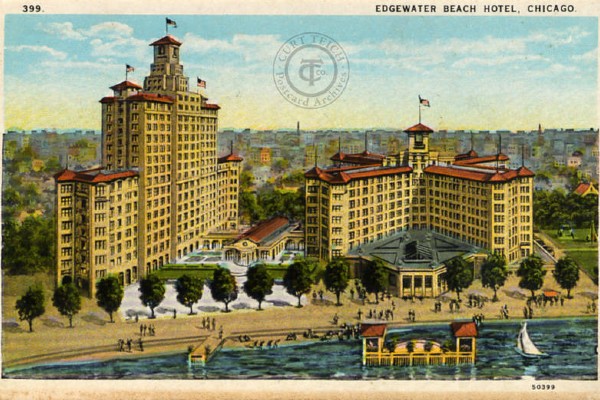The Breakers at Edgewater Beach, now a comfortable Independent Living community, sits on a site of Chicago history. A famous hotspot, the Edgewater Beach Hotel, used to call the area home. From its opening in 1916 to its demolition in 1971, the Edgewater Beach Hotel hosted the celebrated, the glamorous, and the notorious.
Many famous people, from movie stars to musicians, athletes to politicians, stayed at the hotel. Find out more about the Edgewater Beach Hotel in Chicago, IL, and some of the notable people who stayed there.
The History of the Edgewater Beach Hotel in Chicago
The original Edgewater Beach Hotel opened to acclaim in 1916, a cross-shaped structure with 400 rooms. An expansion followed in 1919, with a 600-room building adjacent to the original built in 1923. Apartments followed in a 1928 expansion.
From the 1920s to the 1940s, the hotel was a popular and glamorous location, with golf, dancing, fine dining, floor shows, high-end shopping, swimming, tennis, dancing and a 1,200-foot private beach. It also hosted jazz and big band shows with some of the biggest names of the day, including Tommy Dorsey and Benny Goodman.
By the 1950s, the hotel lost some of its luster when adjacent Lake Shore Drive was extended, cutting the hotel off from its namesake beach. Landfill and pavement replaced green areas and sands that hotelgoers were used to.
In 1967, the hotel abruptly declared bankruptcy, and despite an effort to revive it in 1970, it was demolished in 1971. Only the Edgewater Beach Apartments, part of the 1928 expansion, remain.
Explore Short-Term Stays
The Breakers at Edgewater Beach senior community was eventually built on part of the old hotel site.
25 Notable Guests of the Edgewater Beach Hotel
During its glory days, the hotel was a magnet for the famous and the talented. Here are some of the people who stayed and played at the hotel.
Tallulah Bankhead
Bankhead was a flamboyant stage and screen actress from the 1940s to until just before her death in 1968. Apart from her film roles, Bankhead was known for her liberal politics, wild partying and many affairs. Born in Alabama, her grandfather, father and uncle were prominent in national politics.
Yogi Berra
Berra was a catcher for the New York Yankees in their glory years in the 1940s to the 1960s. He also coached and managed other baseball teams. He was king of the malapropism, accidentally coming up with such classic sayings as “It ain’t over til it’s over” and “Ninety percent of the game is half mental.”
Charlie Chaplin
Chaplin was one of the most famous movie stars and filmmakers of his era. His “Little Tramp” persona was an icon of silent movies, and his films “The Gold Rush,” “City Lights” and “Modern Times” are classics. Chaplain, born in London, had a career that spanned more than 75 years.
Nat King Cole
Cole was a jazz singer and pianist who became a fixture on the pop charts in the 1950s and ’60s. He recorded “Nature Boy,” “Mona Lisa” and the classic “The Christmas Song,” sometimes known by its opening lyrics, “Chestnuts roasting on an open fire.” Cole was the first Black host of a variety show on network television, in 1956.
Bing Crosby
The mellow-voiced Crosby made his mark in radio, television, films and recording. He is considered the first multimedia star, with a singing and acting career that lasted from the 1920s until his death in 1977. Crosby won an Academy Award for his role in “Going My Way” and recorded one of the best-loved holiday songs of all time, “White Christmas.”
Xavier Cugat
Cugat was a Spanish bandleader who was instrumental in the spread of Latin music from the 1940s to the ’60s. Raised in Cuba, his musical stylings provided the soundtrack to dances from the conga and the mambo to the cha-cha and the twist. His orchestra included such noteworthy Latin artists as Desi Arnaz, Tito Rodriquez and Yma Sumac.
Bette Davis
Davis was a gifted actress with a well-regarded, Oscar-winning 50-year career. She won Academy Awards for “Dangerous” and “Jezebel” in the 1930s. She was also nominated nine more times in her career, until 1962’s “What Ever Happened to Baby Jane?” Her forthright manner, clipped speech and omnipresent cigarette became her trademarks.
Jack Dempsey
Dempsey was the world heavyweight boxing champion from 1919 to 1926. He is considered one of the most popular boxers in history, with 68 wins (53 by knockout) in 85 matches. His fights helped pioneer the live broadcast of sporting events, and especially boxing matches. He’s also known for losing a controversial bout to Gene Tunney in 1927.
Tommy Dorsey
Trombonist Dorsey conducted one of the notable big band orchestras of the 1940s. His theme song was “I’m Getting Sentimental Over You,” and his band was also known for “Marie,” “Opus One” and “I’ll Never Smile Again.” Among those who spent time in his band were drummer Buddy Rich and singers Jo Stafford and Frank Sinatra.
Dwight D. Eisenhower
The 34th president of the United States, Eisenhower was raised in Kansas and presided over the nation throughout much of the 1950s. During World War II, Eisenhower was the Supreme Allied Commander in Europe and the five-star General of the Army. He led the invasion of North Africa and the D-Day invasion of Europe.
Mahatma Gandhi
Gandhi began as a lawyer in India and became an anti-colonial nationalist who led the campaign for his country’s independence from British rule. His example of nonviolent resistance became an inspiration for civil rights and freedom movements throughout the world, including in the United States during the 1950s and ’60s.
Judy Garland
Garland was a singer and actress best known for her role in “The Wizard of Oz” and her recording of “Over the Rainbow.” She also starred in “Meet Me in St. Louis” and “A Star Is Born.” She recorded well-received albums and starred in a series of stage and television shows, including her own “The Judy Garland Show” variety hour.
Lou Gehrig
Gehrig was a first baseman with the New York Yankees, setting a record for durability by playing in 2,130 consecutive games in his career until he benched himself early in 1939 because of physical struggles. Later, he was diagnosed with amyotrophic lateral sclerosis (ALS), a neurological disease sometimes called Lou Gehrig’s disease.
Benny Goodman
Goodman, called the “King of Swing,” was a jazz clarinet player and big band leader. For about 10 years, from the mid-1930s to the mid-’40s, Goodman’s band scored the hits “Sing, Sing, Sing,” “One O’Clock Jump,” “Bugle Call Rag” and many more. Goodman’s groups were integrated, featuring Billie Holiday, Teddy Wilson and Lionel Hampton.
Jimmy Hoffa
Hoffa was the controversial president of the Teamsters union until his government-ordered ouster in 1971. Hoffa became involved with organized crime and was convicted of jury tampering and conspiracy, along with other charges, in 1964. In 1975, Hoffa disappeared under mysterious circumstances long believed to be connected to a mob hit.
Bob Hope
Comedian, singer, actor and dancer Hope had a long career of nearly 80 years. He started in vaudeville, moving on to the stage, movies, radio, recording and television. He starred in seven “Road” films with Bing Crosby. For 50 years, he toured with the USO, visiting American servicemen across the globe from World War II to the Persian Gulf War.
Lena Horne
Horne’s legendary career as a singer, dancer and movie actress lasted more than 70 years. She started as a chorus girl at New York’s Cotton Club when she was 16. She also had a long nightclub career after World War II, with occasional well-received TV appearances in the 1950s and ’60s. Her signature tune was “Stormy Weather.”
Martin Luther King Jr.
A Baptist minister and civil rights leader, King hosted a conference on race and religion at the resort in 1963. He gave a major address at the hotel to commemorate the 100th anniversary of the Emancipation Proclamation. He was awarded the Nobel Peace Prize in 1964 for his nonviolent resistance to racism.
Glenn Miller
Miller, one of the key figures of the Swing Era, was a trombonist who led his own big band. Among his signature tunes were “In The Mood” and “Chattanooga Choo-Choo.” In just four years, his band had 16 number-one records. He joined the army in 1942 to entertain troops. His plane disappeared in bad weather over the English Channel in 1944.
Marilyn Monroe
Monroe, and actress and pinup icon, was the sex symbol of the 1950s. She appeared in “Gentlemen Prefer Blondes,” “The Seven Year Itch” and “Some Like It Hot,” for which she was awarded a Golden Globe. Her stormy life included a marriage to baseball star Joe DiMaggio and playwright Arthur Miller.
Franklin D. Roosevelt
Roosevelt, the 32nd president of the United States, was the longest-serving American head of state, elected to four terms. He presided over the New Deal, the end of the Great Depression and the titanic struggle of World War II. He also oversaw the development of the atomic bomb, dying before it could be deployed against Japan.
Babe Ruth
Ruth played 22 seasons in baseball, mostly with the New York Yankees. He retired in 1935 as the all-time home run leader, with 714, a record that held for almost 40 years. Despite his legendary carousing, Ruth is considered a great sports hero and sometimes is called the greatest baseball player of all time.
Artie Shaw
Shaw was a clarinet player and leader of a big band during the Jazz Era. His band had a number of hits, and was best known for “Begin the Beguine,” along with “Stardust” and “Moonglow.” Shaw retired from music after the war, but had a strong influence on popular music, being an early proponent of merging jazz with classical music.
Frank Sinatra
Sinatra grew from skinny songster to the influential leader of the “Rat Pack” of singers and actors. He began his career singing with the Harry James and Tommy Dorsey bands, becoming an 11-time Grammy-winning solo pop singer. He also acted in several films, winning an Oscar for his role in “From Here to Eternity.”
Eddie Waitkus
Waitkus’ tragic story led to a notable novel and movie. Waitkus was a baseball player with the Philadelphia Phillies when he was shot by a female stalker at the hotel in 1949. His shooting and recovery was the inspiration for Bernard Malamud’s novel, “The Natural,” which was made into a movie starring Robert Redford in 1984.
Explore Short-Term Stays
Make Your Own History at the Breakers at Edgewater Beach
The Breakers at Edgewater Beach builds on the legend of the Edgewater Beach Hotel with fun activities and events for seniors. In Independent Living, seniors will have the everyday tasks taken care of as they live a carefree lifestyle. Find out more about Senior Lifestyle and schedule a tour today.

